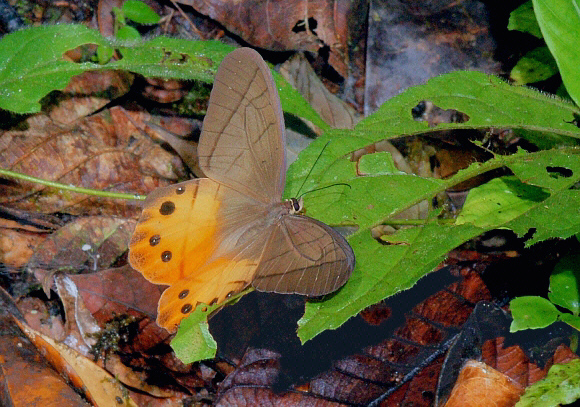
Introduction
The tribe Haeterini is confined exclusively to the neotropical region. All members of this tribe are elusive crepuscular butterflies which spend their lives skulking deep in the undergrowth. There are 5 genera – Pierella, Pseudohaetera, Haetera, Dulcedo and Cithaerias.
The genus Pierella includes 11 species, all confined to the neotropical region. The butterflies can be instantly recognised by their characteristic wing shape, cryptic underside pattern, and their skulking flight just above the surface of the ground, in the darkness beneath the forest understorey.
All members of the genus have brown uppersides, marked on the forewings with thin, feint brown lines, and on the hindwings with dark post-median ocelli or spots. Many of the species have a blue suffusion over the hindwings, while others are marked variously with white, reddish or orange.
Pierella hyceta can easily be distinguished from it’s cogeners by virtue of the colouration of the upperside hindwings – these are suffused with beautiful golden-orange, and have four brown post-median spots. The only species with which hyceta can be confused is P. luna lesbia, which has a reduced and much more clearly defined orange area, and only two brown spots, neither of which fall within the orange area. There is another orange species – nereis, but that has a prominent and very clearly defined white median band that appears on both wing surfaces.

Habitats
This is a pre-montane species, found in wet rainforest at elevations between about 800-1600m. Most other Pierella species however have a greater altitudinal range, typically from about 100-1600m.
Lifecycle
The egg is pale and globular. It is laid singly on young leaves of the foodplant, usually on seedlings. When fully grown the larva is a dull brownish colour, with vague darker markings and many thin longitudinal lines along the back and sides. The head has two short horns, and the tail has a pair of caudal prongs. It feeds nocturnally on Heliconia, possibly also on Calathea ( Marantaceae ). During the day it rests in a head-downwards posture on the lower stem of the foodplant. The pupa is pale brown with dark marbling and mottling on the wing cases and abdomen. It is suspended by the cremaster from woody stems.
Adult behaviour
The butterflies are usually encountered in two’s or three’s along dark narrow forest trails or among bamboo thickets. They fly mainly in the gloom of pre-dawn, but can also be disturbed when walking along trails until mid-morning. Like all Pierella species the flight is low and skulking, but surprisingly rapid, and has been compared with the movements of a ballroom dancer’s feet, hence the common name “Ladies Slipper” or “Lady Slipper”.
Pierella butterflies avoid sunshine, and by late morning have secreted themselves away deep in the undergrowth. They often choose to hide amongst the tangle of rootlets which are found at the base of certain palms. As with other Pierella species they tend to flick their wings open momentarily just after settling but then immediately close them. On rare occasions just after dawn they will bask with the wings outspread for a few seconds but this is rarely observed.
Both sexes feed at decomposing fungi and mouldy fruit on the forest floor.
